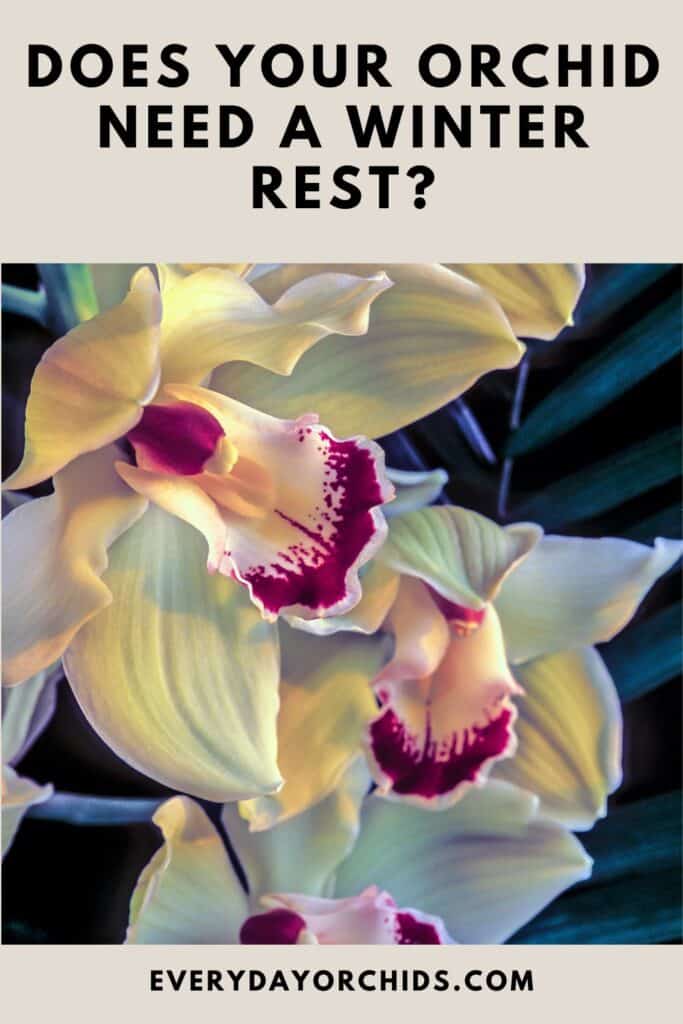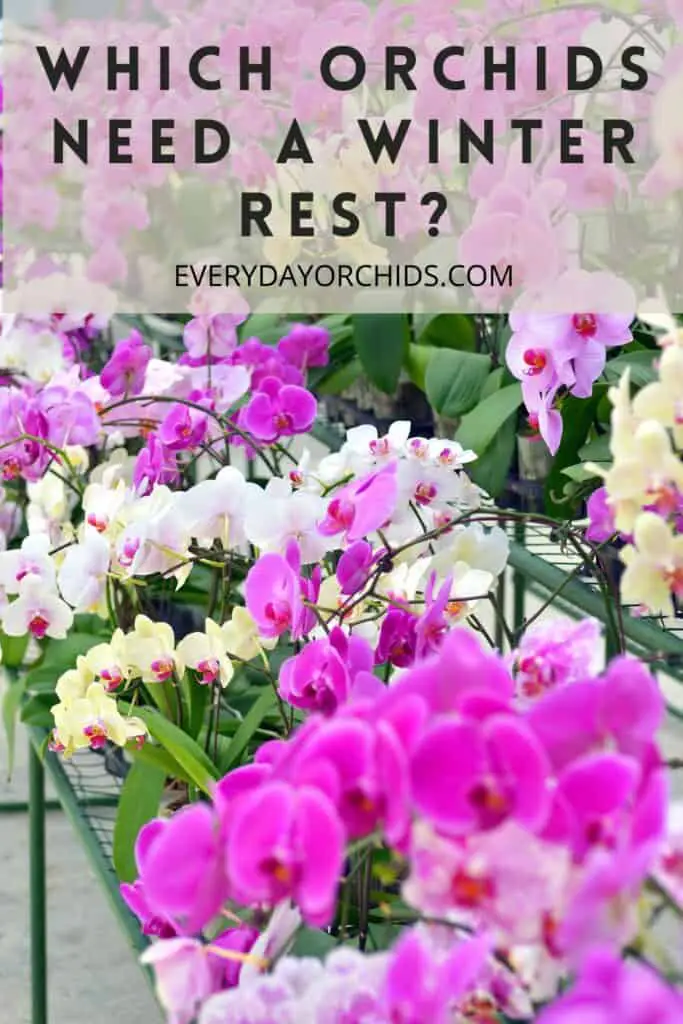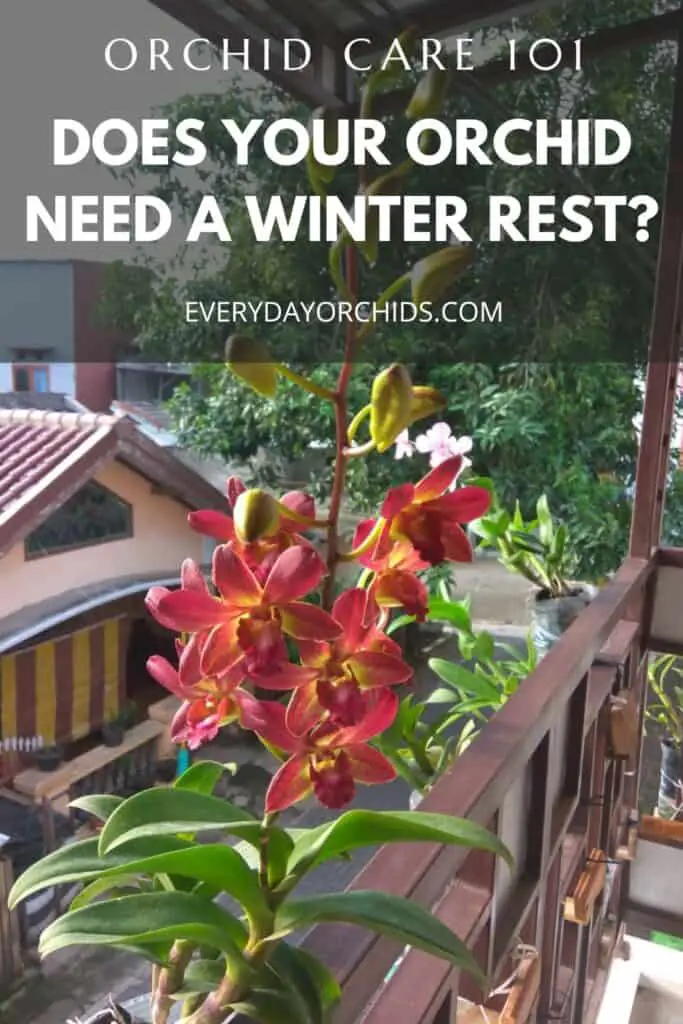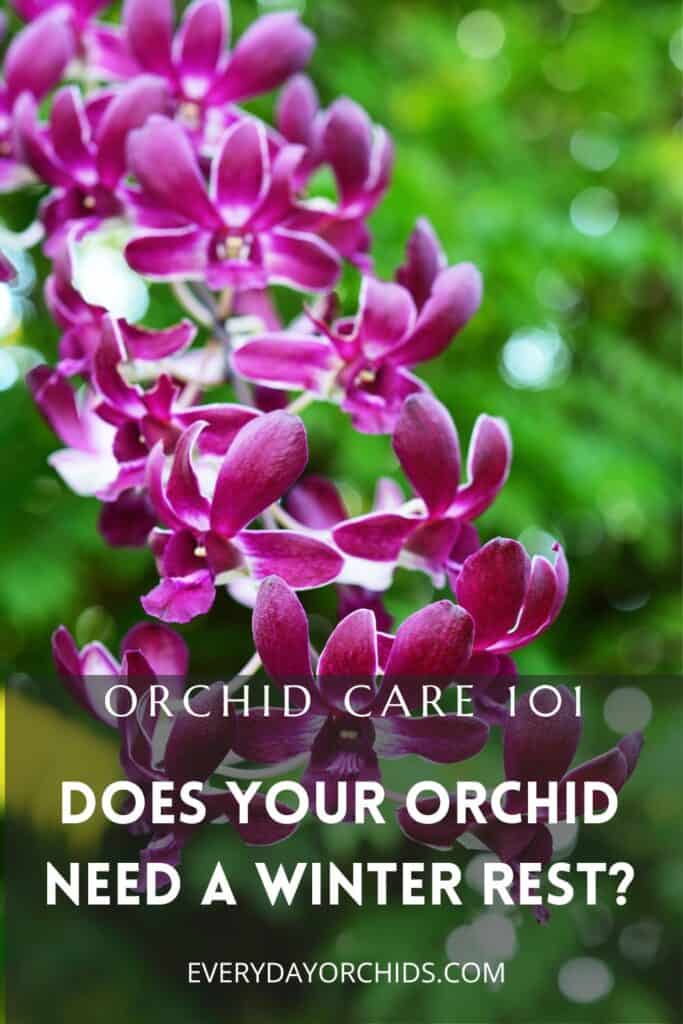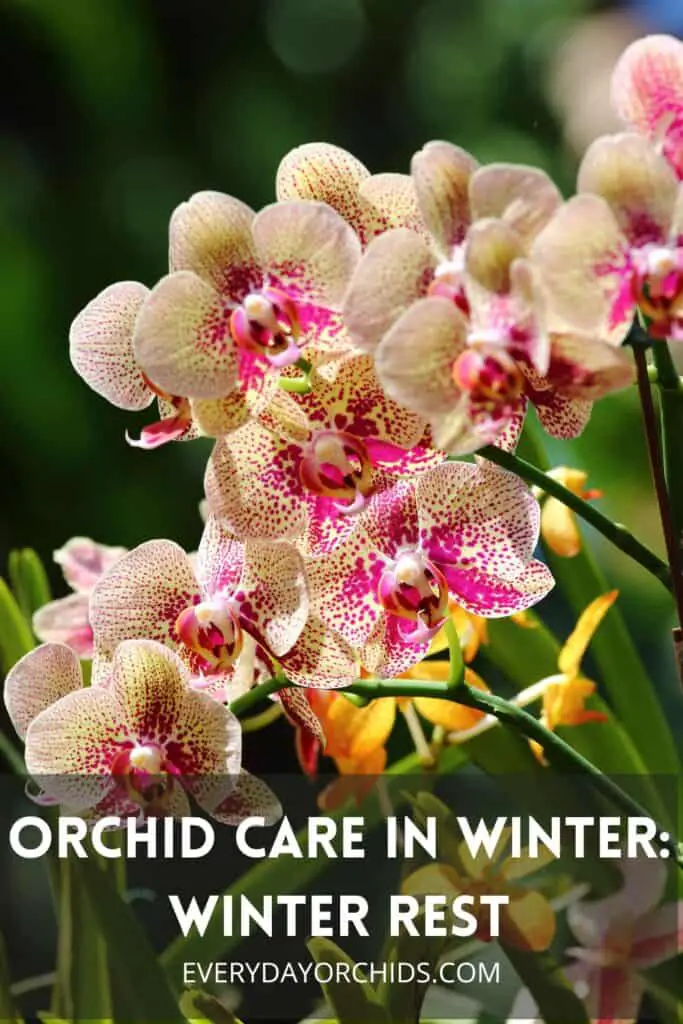When growing orchids, there can be confusion about whether an orchid needs a winter rest or not. After all, there’s such a huge variety of orchids, each with it’s own growing requirements and nuances. Even experienced orchid growers can find it hard to keep things straight, especially if they have extensive orchid collections with many different varieties. So, which orchids need a winter rest?
Many popular orchid varieties, such as the Dendrobium Nobile orchid, need a winter rest. Orchids with the ability to store water in their pseudobulbs and canes are more likely to have a winter rest. Orchids such as Phalaenopsis orchids and Paphiopedilum Lady Slipper orchids do not have pseudobulbs and do not need a winter rest.
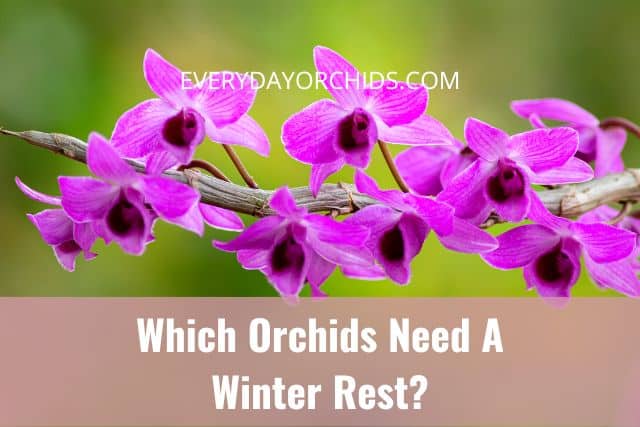
In this article, I’ll highlight some of the most popular orchid varieties that need a winter rest. I’ll also give you information on how to adjust your watering practices to meet the orchid’s winter rest needs.
Please note that these links are affiliate links and as an Amazon Associate, I earn from qualifying purchases. Purchases made through affiliate links in this post may generate commissions at no additional cost to you. Use this link for a discounted Amazon Prime trial. Thank you for your support!
Table of Contents
What Is A Winter Rest?
In orchid growing, a winter rest is a cessation of watering and fertilization during the colder winter months.
If you have an orchid needing a winter rest, you’ll gradually slow watering and fertilization frequency in the fall.
Once the orchid starts losing its leaves, or the weather starts turning colder in late October or November, you’ll want to completely stop watering or fertilizing your orchid.
For more information, read this guide on how to give your orchid a winter rest. There, I go in more detail about the why’s of winter rest in orchid care, as well as how to go about providing a winter rest for your orchid.
Orchids In Winter: Which Orchids Need A Winter Rest?
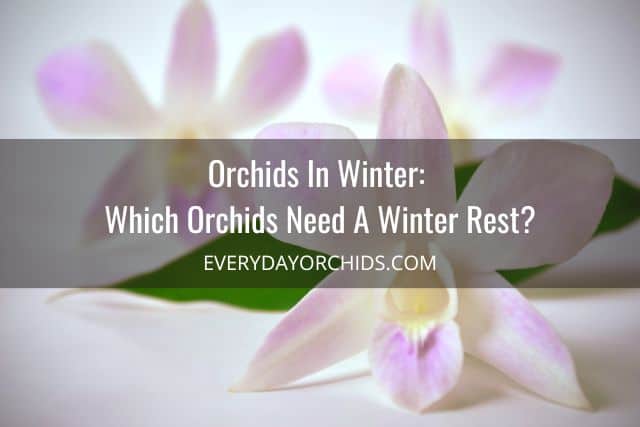
While a winter rest is an essential part of care for many orchids, not all orchids require a winter rest. Winter rest requirements are specific to certain orchid types and varieties.
For example, deciduous orchids that lose their leaves in the winter are more likely to need a winter rest. Catasetum and Dendrobium orchid varieties are examples of these.
In addition, orchids that have a way to store nutrients and water to get them through the winter will have a higher chance of undergoing a winter rest than not. These would include sympodial orchids with pseudobulbs or canes as they have a way to store water for dry periods.
In contrast, monopodial orchids, such as Phalaenopsis orchids, don’t have a method for saving and storing water for extended droughts or dry periods. These types of orchids would not undergo a winter rest.
Below, you will simply find a non-exhaustive list of the more notable orchid species that require a winter rest.
Please be aware that this is not by any means, a complete or exhaustive list. There may be other orchid varieties not listed that do require a winter rest.
To that end, I do recommend getting to know the particular growing requirements for your specific orchid species. This will ultimately help you determine how to best care for your orchid each winter.
Brassavola Orchid Winter Rest
This orchid variety does not drop leaves in the winter, but still needs a winter rest to trigger bloom production.
Brassocattleya Orchid Winter Rest
Brassocattleya orchids are not deciduous orchids. They do not drop their leaves when the temperatures drop in the fall. However, they still do undergo a period of dormancy and winter rest.
Calanthe Orchid Winter Rest
Calanthe orchids usually bloom in the fall. These are deciduous orchids and include the Calanthe cardioglossa, Calanthe punctate and Calanthe rubens orchids.
Once the orchid finishes it’s blooming season and the flowers and leaves fall off, stop watering your Calanthe orchid.
You can resume watering gradually when you start to see new root buds appear. When leaves start to appear in addition to the roots, you can then resume watering normally.
Catasetinae Orchid Winter Rest
This group of orchids includes Catasetums, Mormodes, Clowesia, Cycnoches and their hybrids.
If you have a Catasetinae orchid, you’ll want to gradually decrease watering in the fall months. Water about half as much (or half as often) as you normally would during the growth season.
Then, once you hit winter, stop watering your orchid entirely. Do this even if you still see leaves or flowers on your orchid. If you are in the United States, you’ll stop watering around late December or early January.
This is considered a “dry winter rest,” meaning no water at all during the winter rest period.
Once you start to see root growth on your orchid, you can then begin watering your orchid again. When you do restart watering, be sure to water your orchid generously.
Dendrobium Orchid Winter Rest
There are hundreds, if not thousands, of different Dendrobium species out there. Not every Dendrobium orchid requires a winter rest.
For example, some Dendrobium orchids, such as the Dendrobium Nobile, require a winter rest, while other species such as the Dendrobium Phalaenopsis, do not.
I’ve written an entire article about Dendrobium Nobile care, so if this is your orchid, check it out for more detailed care information.
Dendrobium Nobiles can go without water during its dormant period each winter. This is necessary in order to produce blooms in the spring.
Dendrobium anosmum, Dendrobium lindleyii, Dendrobium senile, Dendrobium aggregatum and Dendrobium aphyllum also undergo a winter rest. These are just a few out of the many Dendrobium varieties that require a winter rest period.
In contrast, the Dendrobium Phalaenopsis orchids do not under go a winter rest and will still need occasional watering. Continue to follow the guidelines of watering orchids, and water when the potting media is nearly dry.
Do not let your Dendrobium Phalaenopsis orchid completely dry out, or else you’ll end up with dried, shriveled orchid roots.
Does Your Dendrobium Orchid Need A Winter Rest?
It’s not a one-size-fits-all approach when you are talking about Dendrobiums.
First, figure out what kind of Dendrobium orchid you have and learn it’s growing requirements.
I recommend checking out this book: Dendrobium and Its Relatives, by Bill Lavarack. It provides a great overview of Dendrobium orchids, broken down into the care needs of different species within the Dendrobium family.
Giving Your Dendrobium Orchid A Winter Rest
In general, if you have a deciduous Dendrobium orchid, it will likely need a winter rest. Stop fertilizing your Dendrobium in late August or early September (if you are in the United States).
Gradually slow watering according to the temperatures. As it cools down, water less frequently until you stop completely for the winter rest.
If the Dendrobium canes begin to shrivel and dry out, you can lightly water your orchid, but avoid routine watering.
During the winter rest period, keep your Dendrobium orchids in a cool, dry place where they will be exposed to lots of bright, indirect light.
Once new flower buds have fully developed on the sides of the canes, you can resume watering. If you start watering too early when buds are just starting to form, then you may end up with orchid keikis instead of flowers.
Lycaste Orchid Winter Rest
Some Lycaste orchids are deciduous and will drop their leaves in the fall. If you happen to see this happening, it is a strong indicator that you have a Lycaste orchid that needs a winter rest.
Stop watering your orchid when the leaves begin to fall. Resume watering in the late winter/early spring, when growth begins again.
Two examples of Lycaste orchids requiring a winter rest period include the Lycaste consobrina and the Lycaste deppei orchid.
Pleione Orchid Winter Rest
These orchids will shed their leaves in the fall. Similar to Lycaste orchids, once this happens, stop watering your Pleione orchid. Leave it in a location where it can receive bright, indirect light.
Other Orchids That Require A Winter Rest
In addition to the orchids mentioned above, Bakeria orchids and Maxillaria Tenuifolia orchids also require a winter rest.
Some Cattleya orchids, such as the Cattleya leopoldii, also do better with a winter rest.
The Laelia mantiqueirae and Rhyncholaelia glauca orchids also need a winter rest period in order to bloom.
Zygopetalum orchids also typically need a winter rest period in order to produce flowers in the spring.
As mentioned before, the orchids mentioned above in this article are just some of the orchid varieties that need a winter rest. It is not a complete or exhaustive list of all orchids that require a winter rest.
If you have an orchid that is not mentioned here, I recommend looking up that specific orchid’s care requirements. That is the best way to definitively know whether or not you should water your orchid in the winter.
Now, just as many orchids need a break from watering and fertilization during the winter, there are just as many orchids that do not take any sort of break at all. You will need to keep on watering these orchids, regardless of the temperature change, in order to keep them alive. I’ll highlight some of these orchid varieties in the next section below.
Orchids In Winter: Which Orchids Do Not Need A Winter Rest?
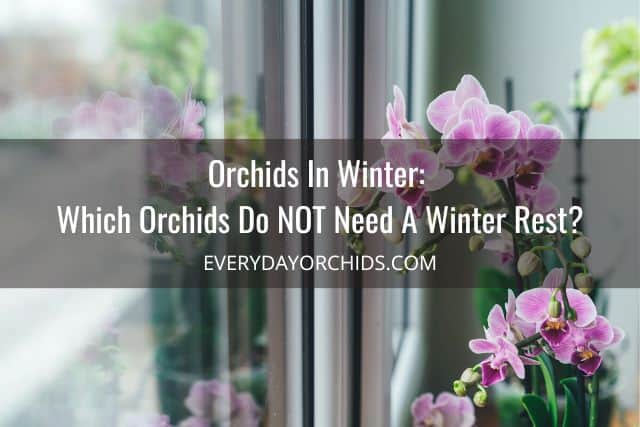
While there are a lot of orchids that need a winter rest, there are many other orchid varieties that do not need a winter rest.
Phalaenopsis orchids are one example of an orchid variety that does not need a winter rest. Oncidiums, some Cattleyas, and some Laelia orchids also do not need a full winter rest. Many of these orchids will continue to grow during the winter months, though at a much slower rate.
Notice that some Cattleya and Laelia orchids do need a winter rest, while others within the same family do not. I know it can be confusing. This partly has to do with whether or not it is a hybrid orchid.
Similar to Dendrobium orchids, there is not a one-size fits all rule that applies to the entire family of orchids. As mentioned above, Dendrobium Phalaenopsis orchids do not need a winter rest, whereas many other Dendrobium type orchids do.
This is why I really recommend learning about your specific orchid variety’s care requirements. I can’t emphasize that enough.
Tolumnia orchids are another orchid variety which do not need a winter rest. However, make sure you are watering less often during the cooler months and allow the orchid potting media to dry out between waterings.
Watering Orchids In The Winter
For these particular orchid varieties that do not need a winter rest, you may be wondering how watering changes during the winter. As in, how often should you water your orchids?
During the winter months, decrease your watering frequency but do not stop completely.
This goes the same for fertilization. Simply decrease fertilization to once a month or so rather than fertilizing your orchid each week.
This reduced amount of watering and fertilization is enough to support your orchid through the winter, especially if it lacks pseudobulbs and does not store water.
Some people refer to this reduced watering frequency as a “semi winter rest.” I personally don’t like this distinction, since I feel it can make things more confusing than they already are.
When trying to figure out how often to water your orchids in the winter, the best rule of thumb is to water when the orchid potting media is nearly dry. The potting media will naturally stay damp longer during the cooler months, extending the time between waterings.
For more information and a detailed guide, read these Everyday Orchids articles on how to water orchids and how to water orchids in moss.
Since it typically rains more in the winter and spring, I’ll also link to this article about whether or not you can use rainwater to water orchids.
Temperature Changes And Winter Rest
Along the same lines, you may be wondering how temperature changes factor into the orchid’s winter rest. Seasonal declines in temperature will cause some deciduous orchids to start to drop their leaves.
The drop in temperatures during the fall and winter months does not trigger dormancy in these orchids. Instead, the temperature drop initiates a cascade of signals that tells the orchid to start flower production.
This is why you’ll often see flower spikes begin to develop on these flowers in mid-winter, particularly in Phalaenopsis and Oncidium orchids.
If you aren’t sure what that new bud on your orchid is, here is a guide on how to tell an orchid flower spike from an orchid root bud.
For winter care tips for these orchids who do not need a winter rest, please check out my winter orchid care guide.
Final Thoughts
As I’ve said before, the best thing you can do for your orchid is to research and learn about your specific orchid’s needs. Get to know it’s nuanced care requirements. This is also how you will know whether or not your particular orchid needs a winter rest or not.
I’ve listed some popular orchid varieties above and highlighted their winter rest needs, and how to go about providing that rest. There are thousands of orchid varieties out there and this is far from a complete list. However, I hope that I’ve given you a good start and an idea of how to better care for your orchid in the winter.
As always, tailor your care to your orchid’s needs. If you notice that your orchid’s pseudobulbs or canes are starting to shrivel significantly and look dry, you may need to lightly mist or water your orchid. Maintain adequate humidity levels around your orchids, as well as good air circulation.
During the winter rest period, keep your orchid in a cool, dry place with lots of bright, indirect light. You may need to use artificial lighting to meet your orchid’s lighting needs, which is totally fine.
All of these factors together will help ensure your orchid remains healthy through the winter and produces flowers in the spring.
Thank you for reading, and as always, happy orchid growing!
